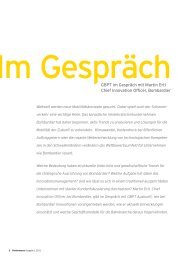PERF RMANCE 04 - The Performance Portal - Ernst & Young
PERF RMANCE 04 - The Performance Portal - Ernst & Young
PERF RMANCE 04 - The Performance Portal - Ernst & Young
You also want an ePaper? Increase the reach of your titles
YUMPU automatically turns print PDFs into web optimized ePapers that Google loves.
Figure 2. Community “critical success factors”<br />
Explicit, agreed-upon<br />
expectations for<br />
measurement and<br />
metrics<br />
Supporting<br />
technology<br />
that meets<br />
community<br />
needs<br />
Connecting<br />
people<br />
Strong, visible<br />
sponsorship and<br />
governance<br />
Community<br />
Rewards and<br />
recognition<br />
Relevant<br />
content<br />
A clear business case,<br />
community charter<br />
and goals/objectives<br />
Engaged<br />
members with<br />
defined<br />
roles and<br />
responsibilities<br />
Clear<br />
expectations<br />
for activities<br />
and deliverables<br />
Successful enterprise communities<br />
must be explicitly sponsored, appropriately<br />
resourced and actively managed to<br />
develop and maintain momentum over<br />
time. Although they may look quite<br />
different from the outside, successful<br />
communities often have many things in<br />
common, including:<br />
1. Strong, visible sponsorship and<br />
governance<br />
2. A clear business case, community<br />
charter and goals/objectives<br />
3. Engaged members with defined roles<br />
and responsibilities<br />
4. Clear expectations for activities and<br />
deliverables<br />
5. Mechanisms and support for<br />
developing trusted relationships<br />
6. Knowledge generation, capture and<br />
transfer processes<br />
Incentives,<br />
recognition and<br />
rewards that<br />
match the culture<br />
Knowledge generation,<br />
capture and transfer<br />
processes<br />
Mechanisms and<br />
support for<br />
developing trusted<br />
relationships<br />
7. Incentives, recognition and rewards<br />
that match the culture<br />
8. Supporting technology that meets<br />
community needs<br />
9. Explicit, agreed-upon expectations for<br />
measurement and metrics<br />
Figure 3. (A) Disconnected groups (B) Boundary-spanning behaviors<br />
Not every successful enterprise community<br />
will have every single one of these;<br />
however, these nine elements form a<br />
good checklist for those looking to begin a<br />
community, or to find ways to add value to<br />
existing communities.






